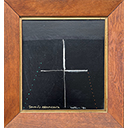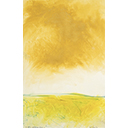Untitled II
139 x 156 cm
 Relative size
Relative size
PROVENANCE
Private Collection, Auckland
Formally part of the Air New Zealand Collection
The early 2000s marked a significant shift in Bill Hammond's oeuvre. Overt references to the Victorian ornithologist Sir Walter Lawry Buller that dominated Hammond's art in the 1990s were replaced by new and diverse historical motifs sourced from artists like James McNeil Whistler, literary works like Dante's Inferno, and the music of Duke Ellington. In addition, the non-descript, airy background of Untitled II signals a shift in mood from the earlier dark underworld characterised by Buller's historical baggage, to a place where Hammond's creatures have transcended to adopt new and varied states of being.
Despite this transformation, the core themes and motifs that make Hammond's work so compelling are at the core of Untitled II, and are further developed in subsequent paintings. Depictions of environmental degradation, land and domesticity are specifically reflected in the activity of the figures. The burly creature with a hook and a freshly uprooted tree under its tattooed arm symbolises nature as both adornment and spoil. Its mountain range tattoo mirrors a mountain-shaped arm ending in an angrily clenched fist. Below, sentry birds watch a globe draining of water, conveying the fragility of the environment. Familiar elements like the floral dress of the kneeling figure hold personal significance, inspired by Hammond's family.
Birds have evolved in Hammond's work, growing in size and significance and reflecting the pivotal roles birds play in mythologies as messengers of the gods and symbols of the spirit world. In Māori mythology the hokioi, the extinct Haast eagle, is often described as a spiritual being that could traverse between realms and was a guardian of knowledge and wisdom. Hammond skilfully draws upon these and other narratives whilst maintaining a sense of emotional restraint in his creatures. He once explained that bird heads were a perfect choice because 'they don't show any emotion - at least none that we can read.' Where conveying emotion is essential, Hammond transforms the birds into shape-shifters, allowing human faces to manifest feelings visibly, as with the Munch-like face embedded in a bird's neck located at the base of the painting.
Hammond's fascination with birds can be traced back to his pivotal 1989 expedition to the Auckland Islands alongside ten fellow artists including photographer Laurence Aberhart and ceramicist Chester Nealie. The journey was met with scepticism by the New Zealand Lands and Surveys Department which questioned whether this 'domain of true scientists' was to become a place 'for the frivolous activities of artists?' Undeterred, Hammond and the others persevered, enduring a five-year struggle for funding and approval from the Royal New Zealand Navy to allow the women in the group to travel on board the transporting frigate. Ultimately, they took matters into their own hands and chartered a private boat for the transformative journey south.
In preparation for the trip Hammond studied bird books including Buller's 1873 tome A History of the Birds of New Zealand. The illustrations were painted by the Dutch artist Johannes Keulemans, who was one of the most highly regarded ornithological artists of the nineteenth-century. Hammond mimics the scientific standard employed by Keulemans by portraying birds grouped together in profile, as with the trio in the top left corner, and depicted in vignettes against a plain background. Buller was also a leading figure in ornithology but his birding practices in Aotearoa New Zealand contributed to the extinction of native species and he remains a controversial figure in history.
The impact of the sub-Antarctic islands on Hammond was profound. The islands, with their inhospitable climate that had thwarted human settlement attempts in the nineteenth-century, were a 'bird land' where large colonies of birds gazed out to sea in a 'beautiful, trance-like state.' Hammond saw the birds as being in charge of their destiny, not Buller nor any other humans, and these ideas fostered an enduring connection with the avian world.
In addition to ornithological art, Hammond also draws on a range of art historical symbols, musical and literary references, including rock music, comic strips, Byobu (Japanese screens), Chinese ink painting, medieval art, Egyptian art, and the work of artists Hieronymous Bosch and Pieter Brugel the Elder. This magpie approach gives additional weight and familiarity to his work. The glass orbs in Untitled II for instance, are motifs drawn from Bosch's sixteenth-century triptych The Garden of Earthly Delights. They are symbolic, conveying the fleeting nature of life and the fragility of earthly joy, themes which permeate many of Hammond's paintings. In 2000 Hammond relocated to a spacious studio in Lyttelton with expansive views of the busy port and surrounding landscape. This change of space refreshed his painting style, and offered ample room for painting on a bigger scale. Untitled II captures this pivotal moment, encapsulating Hammond's sharpened visual storytelling.
Alice Tyler




